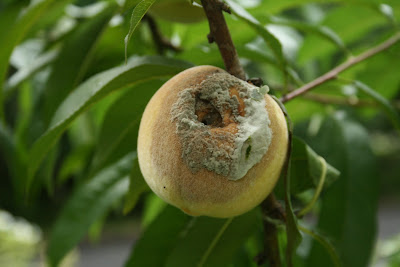Despite a not-so-promising weather forecast we headed north to our friend's cabin off Bear Notch Road near The Kanc for the weekend. Since our hiking legs had rested for a few months we opted for relatively short trails that promised excellent views. On Saturday we drove to Jackson, up Black Mountain Road and then Dundee Road to the small parking lot for the Doubleheads. Here is a view of North and South Doublehead from Black Mountain Road on our way out, after the valley fog had cleared.
The Doubleheads are around 3,000 feet in elevation; a set of peaks that we had never climbed so we weren't sure of the trails. We arrived late morning to an empty parking lot and set off on the Ski Trail - a wide swath that winds its way to the top of North Doublehead after 1.8 miles. We entered fog near the summit, which offered a welcome coolness after a steady climb through warm, humid air. Old man's beard lichen hung from the trees.
We reached the summit (3,053 feet) just in time for a quiet lunch beneath a patch of sun. A couple large rocks provided a nice bench, next to the renovated cabin first built in 1932.
We pushed on through fog to South Doublehead (2,939'). With limited views we quickly began the roughly 1.2 mile descent down New Path. This route back to Dundee Road was steep with loose rock in places. Although views were non-existent atop both peaks, the limited visibility lent a quiet, remote feeling to our hike, especially since we passed only one party -- 4 people and 4 dogs -- as we were nearing the end. We finished the loop after a 1/2 mile hike along Dundee Road back to the parking lot, which was now full (6 cars). This is not a hike that we will hurry back to as the trails and the surrounding forest were not all that interesting, except near the summit. Better views might have altered our opinion.
Sunday dawned brighter and more promising. For this day we chose another new hike - a 3.8 mile round trip hike to Table Mountain off Bear Notch Road.
This turned out to be a leisurely climb along Louisville Brook and through an older northern hardwood forest with big yellow birch and sugar maple. Mushrooms had sprouted on the forest floor and on the trunks of any dead or dying tree. The hobblebush leaves had turned shades of purple, red, and yellow. Clusters of red mountain ash berries stole some of the fall color show.
The trail opens out onto several ledges that offer great views to the south and west. Red maples seemed particularly bright in their fall colors among the dark green of fir and spruce on the upper slopes.
The trail doesn't quite go to the tippy-top of Table Mountain; a young stand of birch, fir, and spruce impede the way. Instead the trail (known as the Attitash Trail) continues on to Big Attitash Mountain. As the book says, this trail is heavily traveled by moose. We saw piles of droppings beneath balsam fir saplings, the preferred winter food of moose.
This hike is well worth another future visit. The views are terrific from the exposed ledges and the woods are beautiful. John over at
1happyhiker has a nice post from June of a loop hike that he did to Table Mountain, which included a bushwhack. He has nice photos and commentary about that option. We returned to the small parking lot off Bear Notch Road the same way we came; Kodi our canine hiking companion was anxious for another dip back in Louisville Brook. We finished this leisurely hike in about 3 hours, just in time for lunch back at the cabin before heading home.











































